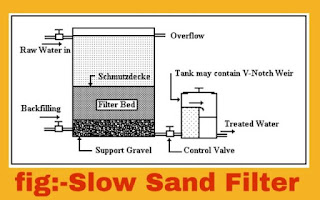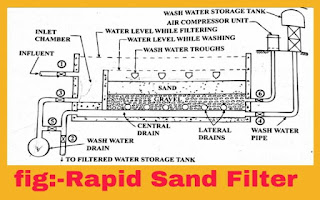Hello friend, today I am going to learn you about differences between the slow sand filter and rapid sand filter. Please read carefully to get full knowledge of it.
The process of passing the water through the bed of porous medium for removing bacteria, color, odor and producing clear and sparkling water is called infiltration. For filtration, filters are used.
The difference between SSF and RSF are lies mainly in:-
1) Head required infiltration
2) Rate of filtration
3) Composition of filter media
4) Method and frequency of clearing the filter media
Slow Sand filter(SSF)
Water is allowed at a very slow rate through the bed of sand hence rate of filtration is very slow. Rate of filtration = 1/20th times through rapid sand filter. Filtration action of SSF is a combination of straining, absorption, and biological flocculation.
Construction of SSF:
It consists of the following parts
i) Enclosure Tank
ii) Filter media
iii) Base material.
iv) Under drainage system.
v) Inlet and outlet arrangement
vi) Other appurtenances
1. Enclosure Tank: – It consists of the open watertight rectangular tank made of masonry or concrete.
The floor has a bed slope of 1 in 200 to 1 in 100 towards the central drain.
Depth of tank 2.5 to 4 m
Plan area of tank 50- 1000 m2 Filtration Rate 100-200 I/m2/h
2. Filter media: Filter media consists of sand layers laid over the top of the base material, gravel. The thickness of filter media 90-110 cm. and should be well graded and washed.
Effective size of sand (Di10)=0.2-0.35 mm (0.3 mm common)
Coefficient of uniformity (CU) 2 to 3 (2.5 commons)
The top portion (15 cm) finer variety and coarse layer at the bottom.
3. Base material: – Base material is gravel which consists of 30-75 cm thick gravel of different size placed in a layer. Generally, 3 -4 layers of 15 to 20 cm depths are used. The course at the bottom and finer at the top.
Depth Size Topmost layer 15 cm. 3- 6 mm
Intermediate ” 6-20 mm
“. 20-40 mm
Bottom layer ” 40-65 mm
4. Under drainage system: – It consists of a central drain which connects all lateral drains. The lateral drains are open jointed pipe drains or some other kinds of porous drains placed 2 to 3 cm c/c of diameter 7.5-10 cm.
5. Inlet and outlet: – Inlet consists of chamber fitted with sluice value or equilibrium float value. Outlet also contains chamber from where a constant discharge from the filter can be maintained under the varying depth of water filter.
6. Other appurtenances:-
i) Measuring loss of head through filter media.
ii) Controlling the depth of water above the filter media.
iii) Maintains constructed rate of flow through the filter.
When a newly constructed or newly washed filter unit is put in operation, the filter head is only 10-15 cm but increases after clogging.
WORKING OF SS FILTER
Water should not be coagulated. Water from the plain sedimentation tank is allowed to enter the filter basin through the inlet chamber. The depth of water should not small but keeps generally the thickness of the sand medium.
The difference in water level in the filter basin and outlet chamber is filter head. For a slow sand filter, it works maximum up to 75 cm or 65 % to 85 % of the thickness of filter media. In the beginning, the filter head is only 10-15 cm.
Cleaning of filter media:-
For cleaning, water in the tank is first drained off. The top layer of sand is scrapped manually and removed through a depth of 15 mm to 30 mm. The top surface is finally racked, roughed, cleaned and wasted with good water. Water is used after 24 to 36 hours later.
The filter requires cleaning after 20-30 days depending upon the impurities present in water and size of filtering media. Cleaning is continued until its depth reaches 60 cm after that refill the filter media.
Rate of filtration: 100 to 200 L/hr/m2 of filter media.
Efficiency and performance: Highly effective in the removal of bacteria and removes up to 98 to 99 % of bacteria
It is not effective in removing water higher turbidity
Removes color 20-25 % color greater than 25 to 30 SSF can’t be used.
Generally better at removing algae from water
Removes some odor and taste.
RAPID SAND FILTER (RSF)
Developed by G. W. Fuller, USA.
In order to reduce the requirement of space and increase the rate of filtration R .S. F. are used. This employ coarse sand having D(10)= 0.5 mm, yields 30 times more than SSF.
Essential features:
1. Enclosure tank. –
2. Filter media.
3. Base material
4. Under- drainage system
5. Other appurtenances
1. Enclosure tank:-
> Depth of tank 2.5-3.5 m.
> Surface area 20-80 m2, each unit arranged in series.
> L/B = 1- 25 to 1.35
> No. of units, N -1.22√Q
> N= No of filter units
>Q= Plant capacity in million liters/day.
2. Filter media:
Depth of sand media = 60-90
Coeff. Of uniformity = 12-1.7 (1.5 common)
Effective size = 0.35-0.6 mm (0.45 mm common).
3. Base material:
In RSF in addition to supporting sand, it distributes the wash water. It consists of 6-90 cm thick gravel of different size, placed in layers. Generally, 5 to 6 layers, each of 10 to 15 cm in depth are used.
Top layer Depth Size
The top layer 15 cm 2-6 mm
Intermediate 15 cm 6-12 mm
intermediate 15 cm. 12-20mm
Bottommost. 15 cm. 20-50mm
4. Under-drainage system:- It serves two purposes
> It collects the filtered water uniformly over the area of the gravel bed
> It provides uniform distribution of backwash water without disturbing or upsetting the gravel bed and filter media.
5. Other appurtenances:-
i. Wash water troughs: – These are provided at the top to collect the backwash water after it emerges from the sand. They are C. I. or R. C. C. troughs spanning across the width or length of the tank. These troughs are generally spaced at about 1.5 to 2.0 m apart.
ii. Air compressor: Provide about 4 minutes @ about 600-800 L/m /sq.m of filter media.
iii. Rate control devices:-Generally values are provided.
iv. Miscellaneous accessories:
a) Head loss indicator
b) Different scale and reading meter
Working & Cleaning Of RSF:-
Controlled by six valves 1,2, 3,4,5 & 6
Value1-Inlet valve.
Value 2-Filtered water storage tank valve.
Value 5-Wastewater valve to drain water from the main drain.
Value 3- Wastewater valve to drain water from the inlet chamber.
Value 4- Wash water storage tank valve.
Value 6-Compressed air valve.
For normal working of the unit, all value is kept closed, except value 1&2. The filter operates under – gravity flow, there being about 2 m head of water over the bed. Filters are normally designed for filtration of 3000-6000 L/ hr/m^2.
I Hope friends, you liked my written article on “Different between slow sand filter(SSF) and rapid sand filter(RSF).” and remains helpful.

